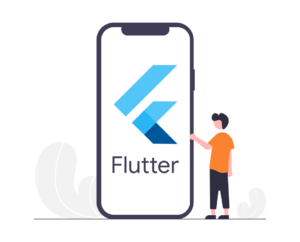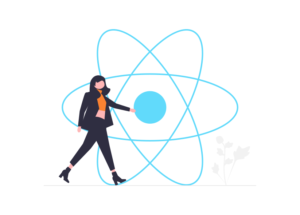
Introduction to Flutter
Let’s deep dive into whether Flutter is good for app development. Flutter is an open-source software development kit created by Google in 2017. It allows developers to build high-performance mobile, web, and desktop applications from a single codebase.
Flutter uses the Dart programming language and provides a modern reactive framework designed specifically for developing user interfaces. It gives developers an efficient way to build and iterate on apps across platforms with high-quality native interfaces.
The key capabilities and benefits of Flutter include:
- Cross-platform development: Apps can be compiled to run natively on iOS and Android from the same Dart code. Flutter also supports building for the web and desktop platforms.
- High-performance UI: Flutter uses Google’s own Skia graphics library to render visuals, providing smooth and fluid animations at 60fps. The reactive framework and widgets also optimize UI performance.
- Hot Reload: Changes made during development can be reloaded instantly without restarting the app, allowing for rapid iteration.
- Extensive widget set: Flutter includes a large collection of pre-built UI widgets, speeding up development. Widgets implement platform differences and provide native look and feel.
- Accessible tools: Flutter offers friendly documentation, lots of samples, and rich tooling support through plugins for IDEs like Android Studio and VS Code.
The main targets for Flutter are mobile, web, and desktop applications. It competes directly with cross-platform options like React Native but has the advantage of a single language (Dart) compared to JavaScript. Flutter aims to make it easier to develop high-quality apps across platforms.
Advantages of Using Flutter
Flutter offers several key advantages that make it an appealing choice for mobile app development:
Cross-platform development: Flutter allows you to develop for iOS and Android from a single codebase. This significantly speeds up development time and reduces the overall cost compared to building native apps for each platform separately. With Flutter, you can release your app on both major mobile platforms without compromise.
Fast development cycle: Flutter’s hot reload feature enables you to view changes instantly without restarting your app. This rapid iteration allows developers to experiment freely and test ideas faster. Flutter’s functional-reactive framework and rich widget set also help accelerate the development process.
Expressive and flexible UI: Flutter provides reactive widgets and powerful tools to create fluid, polished UI. Developers can easily customize widgets and build custom ones for their specific needs. Flutter offers extensive control over the visual elements and layout while still being high-performance.
Popular within community: Flutter is gaining widespread adoption with over 100,000 apps published. The documentation, tools, and resources provided by Google have helped developers get up to speed quickly. Flutter also has an active community that continues to grow, indicating strong long-term support.
Disadvantages of Using Flutter
Flutter has some drawbacks to consider before adopting it as your app development framework:
Dart language barrier: Dart is a relatively new programming language created by Google. It has a moderate learning curve, especially for developers with experience in languages like JavaScript or Java. However, it requires investing time in learning Dart’s syntax and features.
Limited native API access: While Flutter provides platform-specific API access, it doesn’t have 100% coverage of native APIs yet. Complex apps may need deeper integration with native code, which can be challenging with Flutter.
App size: Flutter apps tend to have a larger app size than native apps. This is because Flutter apps include the Flutter engine along with the Dart code. So it may be unsuitable for apps targeting regions with limited bandwidth.
The Dart language and size overhead are tradeoffs for the benefits of cross-platform capabilities and high performance that Flutter provides. While Flutter is actively improving native API access, it may not yet be ideal for apps that require tight integration with native device capabilities.
Flutter vs React Native

Flutter and React Native are two of the most popular cross-platform mobile app development frameworks. Here’s how they compare:
Technical Architecture
Flutter uses the Dart programming language and provides its own widget-based UI framework. React Native is JavaScript-based and renders using native components.
Flutter’s architecture gives it fast rendering and expressive designs. React Native leverages native components for smooth integration with platform APIs.
Community Popularity

React Native benefits from React’s vast community and is used by major companies like Facebook, Tesla, and Walmart.
Flutter is younger but growing rapidly. It’s used by companies like Alibaba, eBay, and BMW. Google’s backing gives Flutter strong credibility.
Performance
Flutter compiles to native code for high performance that can match native apps. React Native’s bridge has overhead that can impact advanced animations.
Flutter has faster hot reloading during development. For simple UIs, both have smooth 60fps rendering. Flutter may have the edge for complex visual apps.
Overall, both frameworks deliver excellent performance. The differences are minor for most mobile apps.
Is Flutter Good for Enterprise Application Development?
Flutter is well-suited for building complex, large-scale enterprise applications due to its strong scalability and maintainability.
Scalable Architecture: Flutter’s layered architecture and reactive programming model make it easy to separate presentation from business logic. This facilitates dividing code into modules and expanding an app over time.
Code Sharing: Flutter’s single codebase allows sharing significant portions of code across platforms. This makes it easier to maintain feature parity across iOS, Android and web apps.
Testing: Flutter has excellent support for unit, integration and widget testing. Automated testing ensures quality and reduces bugs as an app grows larger.
Documentation: Flutter provides extensive documentation and guides for structuring and maintaining large codebases. This helps developers organize and navigate complex projects.
Performance: Flutter compiles to native code and utilises GPU rendering for smooth 60fps animations and transitions even in large apps.
DevOps: Flutter’s hot reload streamlines developer workflows. Automation tooling like CodeMagic facilitates CI/CD and release management for enterprise environments.
Accessibility: Flutter widgets include built-in support for accessibility features on each platform. This helps enterprises build accessible apps that meet regulatory standards.
Overall, Flutter provides the architecture, testing, documentation and performance needed for sustainable development of high-quality enterprise applications. Its active ecosystem also provides the support and tooling for robust enterprise adoption.
Flutter Learning Resources

Flutter provides excellent resources for developers of all skill levels to learn how to build apps with the framework.
The official Flutter documentation covers everything from basic concepts to advanced techniques. It provides in-depth guides on all aspects of Flutter development, including installation, widgets, layout, navigation, state management, accessibility, animations, and more. The documentation is well-organised and includes sample code snippets to help you get started.
Online courses are another great option to learn Flutter. Courses on platforms like Udemy, Pluralsight, and Udacity offer structured learning paths for beginners as well as more advanced developers. These courses walk you through building real-world apps from scratch while teaching Flutter concepts and best practices.
The Flutter team also provides well-documented sample apps and code templates. The Flutter examples repository includes apps demonstrating features like state management, internationalisation, accessibility, and more. These samples show how to solve common use cases and implement best practices. The Flutter gallery contains Material Design widgets and other UI components that can be used as a starting point.
Overall, Flutter has exceptional documentation and learning resources. Between the official docs, online courses, and code samples, developers have everything they need to go from beginner to expert in Flutter app development.
Native Features and Integration
Flutter allows developers to access native platform features and APIs through platform channels and plugins.
Platform channels provide a communication bridge between Dart code and the native language (Java/Kotlin on Android and Objective-C/Swift on iOS). This allows executing native code directly from Flutter. Complex native dependencies like camera, location, notifications etc can be integrated using platform channels.
Plugins wrap the native code in an easy-to-use Dart interface. Flutter has a rich ecosystem of plugins for device APIs, maps, payments, ads, analytics etc. Popular plugins are maintained by the Flutter team.
Flutter allows adding custom native views directly into the widget tree. This is useful when you need to integrate a native UI component that is not wrapped in a plugin. The platform view mechanism allows rendering native views like Android SurfaceView within Flutter.
The key takeaway is that Flutter does not limit you to Dart/Flutter code only. Developers can build custom integrations to leverage native capabilities where required. This makes Flutter flexible enough to build complex apps that may need native functionalities.
Flutter Performance
Flutter uses its own high-performance rendering engine called Skia to draw widgets and animations, which helps it achieve excellent performance that matches or exceeds native apps.
Rendering Speed: Flutter can render at 60 fps or higher, delivering a smooth and responsive user experience. The framework utilizes GPU acceleration on mobile devices to optimise graphics rendering. Tests have shown Flutter apps can render smoother UI animations than native iOS or Android.
Startup Time: Flutter has relatively fast startup times, allowing apps to launch quickly. Flutter’s code is pre-compiled into machine code using Dart’s AOT (ahead-of-time) compiler, reducing the work needed at startup. Apps can launch under a second on many devices.
Memory Usage: Flutter has an optimised memory footprint, allowing apps to run efficiently. Unused widget trees are garbage collected, and the framework reuses UI elements when possible. The memory footprint is comparable or lower than native iOS and Android apps according to research. Flutter provides tools to track and analyze memory usage as well.
Overall, Flutter’s performance makes it highly suitable for building complex mobile applications with demanding graphics, animations, and navigation. The combination of a reactive framework and rendering engine allows Flutter to achieve native-level performance across a range of metrics.
Testing Flutter Apps
Testing is a critical part of app development to ensure quality and reliability. Flutter provides robust testing capabilities to thoroughly validate app functionality and logic.
Unit Testing
Unit testing allows developers to test individual classes, functions or components in isolation. Flutter uses the test package which provides a rich set of matchers and utilities for unit testing. Some key features include:
- Test widgets, business logic, utilities, etc. independent of application environment.
- Execute tests quickly without slow runtime environments.
- Integrates with popular test runners like test api.
- Supports mocking dependencies, allowing focused unit testing.
Unit testing helps catch bugs early, enables safe refactoring of code, and reduces regression issues.
Widget Testing
Widget testing verifies the UI and output of application screens and widgets. Flutter provides the flutter_test library for widget testing. Developers can:
- Render application widgets and verify output.
- Tap, scroll, enter text and simulate user interactions.
- Ensure UI matches specifications and design mocks.
- Identify visual regressions across app updates.
Widget testing provides confidence in the visual fidelity and behaviour of UIs.
Integration Testing
Integration testing validates how different modules and components work together as a whole. Flutter apps can be integration tested on both emulators and real devices using tools like Flutter Driver. Key capabilities include:
- Drive tests for user flows across multiple screens.
- Isolate test execution from application code.
- Test on emulators or connected devices.
- Supports testing with continuous integration systems.
Thorough integration testing is vital for complex apps to catch issues not detectable at unit or widget level. Flutter provides flexible options to test apps at multiple levels.
Conclusion
Flutter provides a compelling option for cross-platform app development with its modern reactive framework, fast development cycle, and rich widget set. For those looking to target both Android and iOS platforms, Flutter has clear advantages over native development in terms of time and cost savings.
The tradeoff is reduced access to some native features and potentially larger app size. Flutter works best for apps that prioritise speed, expressive UI, and a unified cross-platform experience over extensive hardware integration or maximum performance. It shines for startup MVPs, simple content-driven apps, and utility apps where it can leverage its strengths.
As Google continues investing in Flutter and expanding it to web and desktop, its ecosystem and tooling will likely improve. If Flutter can resolve lingering issues around app size, native integration, and performance, it could become a dominant choice for most mobile and multi-platform development needs. But for now, some complex apps and games may still benefit from native development’s optimisation and full feature access.
Overall, Flutter lowers the barriers to high quality cross-platform app development. For many use cases, it represents the future of how mobile apps will be built – with a portable codebase deployed to multiple operating systems. Its growing community, documentation, and widget catalog make Flutter a great framework to learn for any mobile developer.
